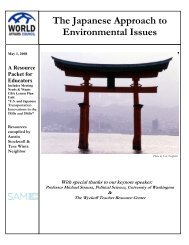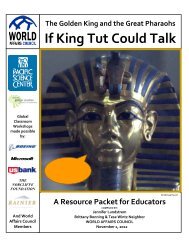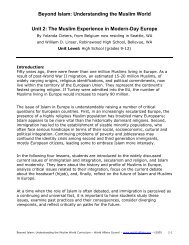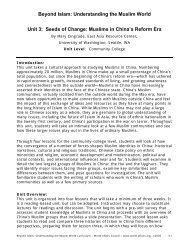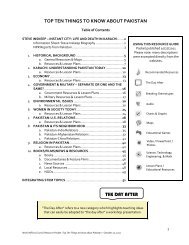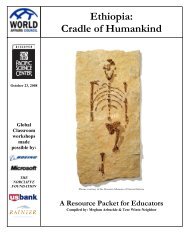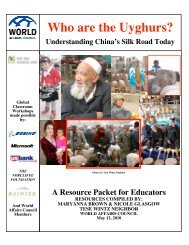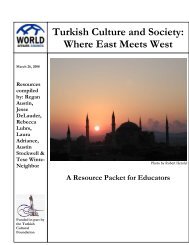turkey on our minds and in our classrooms - World Affairs Council
turkey on our minds and in our classrooms - World Affairs Council
turkey on our minds and in our classrooms - World Affairs Council
Create successful ePaper yourself
Turn your PDF publications into a flip-book with our unique Google optimized e-Paper software.
HISTORY AND CULTURE<br />
Turkey Unit by C<strong>on</strong>nie Johns<strong>on</strong> & Tammi Lundberg<br />
http://www.outreachworld.org/res<strong>our</strong>ce.asp?CurriculumID=33<br />
This unit touches <strong>on</strong> the history, culture <strong>and</strong> people of Turkey. It aims to expose students to a Middle<br />
Eastern country <strong>in</strong> a positive way. The activities focus <strong>on</strong> the theme of compare <strong>and</strong> c<strong>on</strong>trast,<br />
compar<strong>in</strong>g Turkish life with American students' experiences.<br />
The Byzant<strong>in</strong>e Empire "C<strong>on</strong>stant<strong>in</strong>ople, the Capital of the Byzant<strong>in</strong>e Empire"<br />
http://www.glencoe.com/sec/socialstudies/worldhistory/hh2004/c<strong>on</strong>tent.php4/1320/5<br />
Students will use <strong>in</strong>formati<strong>on</strong> from The Travel Guide for Istanbul <strong>and</strong> Turkey Web site to learn about<br />
the ancient city of C<strong>on</strong>stant<strong>in</strong>ople. Students will browse "The Byzant<strong>in</strong>e" topic to read about the city's<br />
history <strong>and</strong> its Byzant<strong>in</strong>e art <strong>and</strong> architecture. Students will then answer f<strong>our</strong> questi<strong>on</strong>s <strong>and</strong> apply this<br />
<strong>in</strong>formati<strong>on</strong> by prepar<strong>in</strong>g an oral presentati<strong>on</strong> <strong>on</strong> the people <strong>and</strong> culture of C<strong>on</strong>stant<strong>in</strong>ople.<br />
Turkey Traditi<strong>on</strong>s <strong>and</strong> Today<br />
http://www.less<strong>on</strong>planet.com/search?keywords=<str<strong>on</strong>g>turkey</str<strong>on</strong>g>+country+of&media=less<strong>on</strong><br />
Students research <strong>and</strong> analyze nati<strong>on</strong> build<strong>in</strong>g, identify<strong>in</strong>g countries established for various reas<strong>on</strong>s.<br />
They study the history of the l<strong>and</strong> now called Turkey <strong>and</strong> Ataturk, Father of the Turks. They identify the<br />
different ethnic groups that make up the nati<strong>on</strong> <strong>and</strong> create a visual representati<strong>on</strong> of their cultural<br />
studies to present orally to classmates. (Rated grades 4-12)<br />
All Roads Lead to Istanbul: 1550 <strong>World</strong>’s Fair Simulati<strong>on</strong><br />
Less<strong>on</strong> plan: http://cmes.ariz<strong>on</strong>a.edu/sites/cmes.ariz<strong>on</strong>a.edu/files/files-picturegallery/1.%20Less<strong>on</strong>%20plan.pdf<br />
This series of five less<strong>on</strong>s, Students will learn about the historical importance of Turkey as an<br />
<strong>in</strong>tersecti<strong>on</strong> for global trade. Students will bra<strong>in</strong>storm, map, compare timel<strong>in</strong>es, <strong>and</strong> f<strong>in</strong>ally create a<br />
presentati<strong>on</strong> for a class room “world’s fair” , represent<strong>in</strong>g different nati<strong>on</strong>s which had trad<strong>in</strong>g <strong>in</strong>terests<br />
<strong>in</strong> the Ottoman Empire.<br />
Nasredd<strong>in</strong> Hodja: Turkish <strong>and</strong> Middle Eastern Folklore Philosopher<br />
http://www.cmes.ariz<strong>on</strong>a.edu/outreach/less<strong>on</strong>plans.php<br />
This less<strong>on</strong> <strong>in</strong>troduces Nasredd<strong>in</strong> Hodja, the Turkish <strong>and</strong> Middle Eastern folk philosopher. It can be used<br />
<strong>in</strong> c<strong>on</strong>juncti<strong>on</strong> with other folk stories from around the world. Students already should have a work<strong>in</strong>g<br />
knowledge of folk tales, fables, as well as tall tales. Two of the Hodja tales have <strong>in</strong> turn been written<br />
<strong>in</strong>to a reader’s theater script to help students work <strong>on</strong> their fluency.<br />
The Ottoman Empire<br />
http://school.discoveryeducati<strong>on</strong>.com/less<strong>on</strong>plans/programs/suleyman/<br />
Students will underst<strong>and</strong> the geographic span <strong>and</strong> ec<strong>on</strong>omic importance of the Ottoman Empire dur<strong>in</strong>g the<br />
reign of Suleyman the Magnificent. (Grade Levels 9-12)<br />
<strong>World</strong> <strong>Affairs</strong> <strong>Council</strong> Res<strong>our</strong>ce Packet: What the Rest of the <strong>World</strong> can Learn from Turkey Today – March 20, 2012 32



